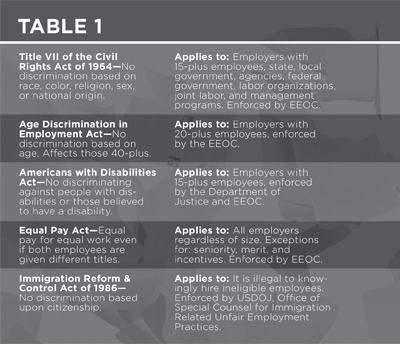
Small Business Documents: Protecting and Running Your Business, Part II
By Beth Borrego / Published May 2015

Editor’s Note: Part I in this series, “Small Business Doc-uments: Protecting and Running Your Business,” was published in the April issue of CT|IWA. To read Part I in its entirety, please visit www.cleanertimes.com.
In addition to the documents and receipts already mentioned, there are a variety of internal documents that are also important to implement. These documents provide internal structure and aid in the documentation of daily events while giving the business structure and order. Policies and procedures are important and provide boundaries and direction to employees. However, before you begin drafting documents, it’s worth mentioning that there are laws, which you must abide by. It’s important to familiarize yourself with them and to understand their impact on your business because these laws are designed to protect the rights of the people (see Table 1).
 Before you hire anyone, you’ll no doubt be interviewing them. An employment application is an important document, and should be used for all applicants, although some may have resumes. Make certain your application does not request anything that you may be prohibited from asking, and make certain you are aware of what you can and cannot ask of any applicant. Check with your state for specifics, but some of the questions that you may and may not ask are found in Table 2.
Before you hire anyone, you’ll no doubt be interviewing them. An employment application is an important document, and should be used for all applicants, although some may have resumes. Make certain your application does not request anything that you may be prohibited from asking, and make certain you are aware of what you can and cannot ask of any applicant. Check with your state for specifics, but some of the questions that you may and may not ask are found in Table 2.
 Let all applicants know how long the application will be active and on file. Inform them that all hiring decisions are based upon the current information provided on the application, and that if that information changes, they would need to submit a new application reflecting any updated changes. This may include information such as their contact information or employment history, for example. It’s helpful to obtain and check references from former employers. In contrast, it’s not typically a good idea to contact friends or family members for references, since they would be biased and not reflective of the applicant’s work history or capabilities on the job. Make sure that your application has a statement making it clear that falsifying the application is considered grounds for termination. It’s appropriate to have the applicant sign and date the application; it’s also considered due diligence to contact references, perform background checks, and require drug testing as a part of the company’s hiring process.
Let all applicants know how long the application will be active and on file. Inform them that all hiring decisions are based upon the current information provided on the application, and that if that information changes, they would need to submit a new application reflecting any updated changes. This may include information such as their contact information or employment history, for example. It’s helpful to obtain and check references from former employers. In contrast, it’s not typically a good idea to contact friends or family members for references, since they would be biased and not reflective of the applicant’s work history or capabilities on the job. Make sure that your application has a statement making it clear that falsifying the application is considered grounds for termination. It’s appropriate to have the applicant sign and date the application; it’s also considered due diligence to contact references, perform background checks, and require drug testing as a part of the company’s hiring process.
Once you have successfully hired the desired candidate, you’ll want to present them with various documents to read and sign. These documents should become a part of their personnel file. When an offer is extended to the successful applicant, it’s important to let them know what kinds of documents they will need to fill out, in case they have an objection. Two common but necessary documents that aid in protecting your company are the non-disclosure and the non-compete agreement. A non-disclosure agreement basically means that what is shared or discussed must remain confidential and may not be discussed outside of the workplace. It’s also known as a confidentiality agreement. The other document is the non-compete, which basically protects your company from those who would choose to work for you short-term with the interest of leaving and starting up a competing business. It’s important to note that some courts take a dim view of these agreements, and the wording of them should be very specific. For this reason, it’s wise to spend the money and have an attorney specializing in that area of the law draw one up for you.




